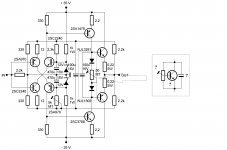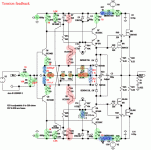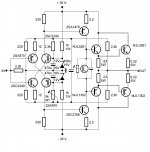Hum....Unfortunately, many good sounding amps are less stable and have higher THD.
Do you prefer to *create* "Good sound" or have a transparent system ?
Distortion IS distortion. of course all the question is what kind of distortion and how to measure-it.
I think so. The simplicity of a design don't lie on the number of spare parts you can look on the schematic, but the number of parts *involved* in the signal treatment.We are sure on the same wavelenght Christophe.
Adding components to stabilize elements do not have bad sonic impact... on the contrary.
Any attempt to stabilize gains, bandwitchs, currents, offsets and temperatures are welcome and bring sonic benefits.
More than that, pre-compensing distortions, increasing open loop bandwitch is better than using global feedback. In that matter, and as an example, i do not look at cascodes as a two devices circuit, but a better *single one* transistor.
Your advanced SSA is as simple than the primitive one. Exactly the same principle.
Same food; better service.
I wonder too why some people are afraid with more recent devices, like IGBT.
If they show better characteristics, i believe they would sound better.
Of course, we do not know how to measure everything, but magic "audiophile" approach is not a way. LC, you knows what you are doing, for sure, and i agree with near all your choices.
That-s for sure, and it is my religion since years. In fact, it is the FISRT thing a look in an amp. Slew-rate or open loop bandwidth (IE phase and IM distortion). One of the reasons i'm devoted in "current" feed-back.Phase change over level. I could imagine that a wide band amp has less of it. I sure second the view that high bandwidth is better. Maybe not under the circumstance of sine waves heard, i am stone deff over 16kHz, but as a dynamic phenomenon.
Last edited:
Hum....
Do you prefer to *create* "Good sound" or have a transparent system ?
Distortion IS distortion. of course all the question is what kind of distortion and how to measure-it.
Of course, distortion IS distortion, nobody wants it, not us. But the effort to reduce distortion, may or might create another kind of unknown "distortion". TIM, IMD, who cares what the name is, measurable or not, it is there, very "audible". So a good distortion versus bad unknown "distortion", why not? Real life sound also has distortion.
Go to live music performance and rate the quality of the music. Say 90. Then buy a recorded performance then "rate" the quality of the recording. Say 60 (bad recording they say
On the Blowtorch thread we are discussing differential phase at the moment. Phase change over level. I could imagine that a wide band amp has less of it. I sure second the view that high bandwidth is better. Maybe not under the circumstance of sine waves heard, i am stone deff over 16kHz, but as a dynamic phenomenon.
I can agree with this ....
well, as you say, there are many forms of distortion, but I would not agree that all distortion is objectionable, and harmonic is OK if it is monotonically related. And with around 1% harmonic distortion, the amplifier might sound a little valve-like.Of course, distortion IS distortion, nobody wants it, not us. But the effort to reduce distortion, may or might create another kind of unknown "distortion". TIM, IMD, who cares what the name is, measurable or not, it is there, very "audible". So a good distortion versus bad unknown "distortion", why not? Real life sound also has distortion.
Go to live music performance and rate the quality of the music. Say 90. Then buy a recorded performance then "rate" the quality of the recording. Say 60 (bad recording they say). Now play the recording through a transparent system. Because the system is "perfect", the quality of the sound is thus 60. Now play the recording through a "non-transparent" system, and the sound is closer to the live performance, so rated 80. I prefer the non-transparent system


I have measured the harmonics from a saxophone, up to the 32nd harmonic, and it sounded wonderful, as long as the sound source was a sax, and not a flute!
Adding components to stabilize elements do not have bad sonic impact... on the contrary.
I wonder too why some people are afraid with more recent devices
Reluctance, due to years of bitter experiences with multitude of devices meaning band aids on slow circuits and tons of feedback, and bogus perfect new concept claims. Not Andrej's purpose of course. On the other hand if we see each device as carrier of silicone capacitors (cob etc.) maybe there is something into the ''esoteric'' less is more philosophy. Hand waving big time talk, yeah!

By habit, i would note the contrary. If the sound engineers are minimally talented, recordings sound often better than the live performances, because microphones are ideally positioned , not the audience, PA systems, if any, far, so far, to be transparent, and you're able to correct and *magnify* a lot of things during mixage, including musicians mistakes or their bad balances.Go to live music performance and rate the quality of the music. Say 90. Then buy a recorded performance then "rate" the quality of the recording. Say 60 (bad recording they say).
Well, one thing you cannot replace is the life's images and shared audience emotion and recording is always canned music ;-)
Music you reproduce is recorded. Audiophiles tries to compare with so calling real sounds. But they have no ideas of what is the source. As a sound engineer, i don't have this approach, but i try to evaluate how a given element modify a known source. Reason why i don't go for tube amps, vinyls or 78rmps records ;-) and all that kind of esoteric nostalgia.
Well, to return to the topic, and as far i'm concerned, i will just say that my SSA amp is the closest to perfect (transparent) amp i've ever listened. I had tuned-it with measurements in mind, and the sound respect the measurements. And this amp is able to reproduce very disagreeable recordings in a very disagreeable manner, what i expect from an amp.
I wonder too why some people are afraid with more recent devices, like IGBT.
If you're being positive, it (the question) is for you something that is not too difficult to answer. Me for example, why should I afraid of the IGBT? I have many IGBTs. I have built IGBT amps.
There are so many circuits on the net. I cannot build them all. Luckily, like you and everyone else, my experience allows me to be able to choose which ones to build, which ones to be put on the waiting list (Currently I'm building my own interpretation of TCJ Hybrid Tube Power Buffer to be compared with Aleph-J)
If they show better characteristics, i believe they would sound better.
So you are after better characteristics, then assume that they sound better. Me, I build and listen, not really cares with characteristics. Characteristics only used as a tool to help achieve the expected result faster. It is actually very simple. I only build, not design. What is being heard is more important than whatever numbers associated with it.
And amp building is only a hobby. For sound quality, I rely on speakers, not amps. For amps, I rely on good execution.
The simplicity of a design don't lie on the number of spare parts you can look on the schematic, but the number of parts *involved* in the signal treatment.
Here you have assumed that you know precisely which parts are being "involved" and which parts are being "not involved".
Adding components to stabilize elements do not have bad sonic impact... on the contrary.
Here you have assumed that you can hear sonic impact as good as anyone. If you can't hear any impact, then there is no impact.
Of course, we do not know how to measure everything, but magic "audiophile" approach is not a way..
May be we have to consider these "audiophile" as people who have different characteristics, and have different needs than us. Consider these 2 characteristics for example:
(1) People love for music.
(2) People ability to perceive subtle changes in sound.
Love for music has nothing to do with electronics hobby, has nothing to do with electronics expertise. If you don't like music, you don't. Your expectations from an audio system might be different than those who like to listen to music.
Music lovers listen to music to be happy. They build audio system also to be happy. Non-music lovers, may also build audio systems, even design them. But who knows what the purpose is. May be to satisfy music lovers???
Everyone can consider themselves as music lovers. I have seen people listen to music almost every minutes every day. I learn from them. I mean I tried to think what it is in their CHEAP audio system that allow them to listen to music every day. The answer is "sonic" (that brings musicality) and non-existence of certain type of distortion from an easy-to-drive full range drivers.
When I like my audio system, I cannot stop listening to it. I don't sleep, I don't even go to work! But If I don't like it, I don't want to listen to it. So when people say that they audio system is top notch, but they don't listen to it frequent enough, I know for sure what that means.
Audio is like food. People may have different taste and expectation, but good food is good food, and good cook is good cook. Good food is everlastingly sought after, and good cook create the good food. Good cook do not claim their expertise from how fast they cook, like amp designers claim how low their THD.
I really like this it sort of nails what its all about....creating the dynamic drive from the buttom that gives music life...with out it does not matter how clear the triangle in the corner is an how detailed the sound....live and lifelike is the way..the only way...
.
"When I like my audio system, I cannot stop listening to it. I don't sleep, I don't even go to work! But If I don't like it, I don't want to listen to it. So when people say that they audio system is top notch, but they don't listen to it frequent enough, I know for sure what that means.
Audio is like food. People may have different taste and expectation, but good food is good food, and good cook is good cook. Good food is everlastingly sought after, and good cook create the good food. Good cook do not claim their expertise from how fast they cook, like amp designers claim how low their THD."
Thanks
.
"When I like my audio system, I cannot stop listening to it. I don't sleep, I don't even go to work! But If I don't like it, I don't want to listen to it. So when people say that they audio system is top notch, but they don't listen to it frequent enough, I know for sure what that means.
Audio is like food. People may have different taste and expectation, but good food is good food, and good cook is good cook. Good food is everlastingly sought after, and good cook create the good food. Good cook do not claim their expertise from how fast they cook, like amp designers claim how low their THD."
Thanks
, i will just say that my SSA amp is the closest to perfect (transparent) amp i've ever listened. I had tuned-it with measurements in mind, and the sound respect the measurements. And this amp is able to reproduce very disagreeable recordings in a very disagreeable manner, what i expect from an amp.
Do you still have your SSA thread going ...?
I really like this it sort of nails what its all about....creating the dynamic drive from the buttom that gives music life...with out it does not matter how clear the triangle in the corner is an how detailed the sound....live and lifelike is the way..the only way...
.
"When I like my audio system, I cannot stop listening to it. I don't sleep, I don't even go to work! But If I don't like it, I don't want to listen to it. So when people say that they audio system is top notch, but they don't listen to it frequent enough, I know for sure what that means.
Audio is like food. People may have different taste and expectation, but good food is good food, and good cook is good cook. Good food is everlastingly sought after, and good cook create the good food. Good cook do not claim their expertise from how fast they cook, like amp designers claim how low their THD."
Thanks
Dammit ... now i'm hungry ...............
www.esperado.fr - Le crescendo revisitéDo you still have your SSA thread going ...?
Going to build simplest BJT SSA as attached, temporarily cannot get thermaltrack BJT. Don't know how to calculate the value of capacitor(what is it used for ?seems like bypass signal) & VR pot and any capacitor should work ? (as long its thermal conductivity is ok ? like BD139)........ Absent? You have to have something in that string to create a voltage spread of about 1.2V between the bases of the output devices. Simplest thing is a resistor, but that gives you no thermal compensation. With a big enough heat sink you can do this. Or, if you use lateral mosfets on the output, you don't need thermal compensation, because they conduct less as they get hotter.
Diodes are next simplest, and if on the die or heatsink will provide thermal compensation. A VBE multiplier, next. Here's the simple version of the multiplier: http://www.diyaudio.com/forums/atta...313313292-simple-symetrical-amplifier-ssa.jpg
Sheldon
Hope someone could guide me.
Another question is regarding MOSFET and IGBT ( I have no knowledge nor experience using them). Is it able to use any MOSFET & IGBT in place of similar capability MOSFET/IGBT ? (It seems BJT is easier to handle, but interested to use those in future)
Attachments
Hvala za odgovor, ali je na francuskom, pa pretpostavljam da se ne radi DIY onaj koji je započeo ....
Is this the one you have up and running ?
Attachments
Last edited:
Member
Joined 2009
Paid Member
Going to build simplest BJT SSA as attached...
Although I have not tried this, I would be concerned that this circuit is 'too simple' because the VAS devices driver the power output devices directly - conventional approach insists that for Class AB you want at least another pair of emitter followers in there. This is why I designed the TGM5 version. On the other hand I have never tried such a simple output and it may work really well.
So Bryan if there is a beauty in simplicity, here's the simplest SSA version of them all just for you.
Best regards, Andrej
Thank you Andrej for this Beauty in simplicity. Can you kindly provide a similar beauty in simplicity using only BJTs?
DO you mean something like my draft attached ? (more output stages) Will this relieve the VAS somehow ? (the emitter resistor value is estimation only....)Originally Posted by Bigun :
Although I have not tried this, I would be concerned that this circuit is 'too simple' because the VAS devices driver the power output devices directly - conventional approach insists that for Class AB you want at least another pair of emitter followers in there. This is why I designed the TGM5 version. On the other hand I have never tried such a simple output and it may work really well.
Or is there any better implication ?
Attachments
according to here (about thermal track):
At about bottom of page 2, it written that the trimpot can be remove.... :
It is true or possible ? this may make the circuit simpler and less component to tweak ? (or will it lead to less area to improve manually? )Another benefit of the modified circuit is the fact that it can be implemented without the use of a bias trimming potentiometer.
Gareth,
It works fine for rails not higher than 36V and will deliver good results with at least 10mA flowing through the VAS. Laterals are incredibly easy to drive!
Hugh
because the VAS devices driver the power output devices directly - conventional approach insists that for Class AB you want at least another pair of emitter followers in there.
It works fine for rails not higher than 36V and will deliver good results with at least 10mA flowing through the VAS. Laterals are incredibly easy to drive!
Hugh
Hm.... do you refer to which schematic ? the thing Bigun talking about is BJT system ?Gareth,
It works fine for rails not higher than 36V and will deliver good results with at least 10mA flowing through the VAS. Laterals are incredibly easy to drive!
Hugh
- Status
- This old topic is closed. If you want to reopen this topic, contact a moderator using the "Report Post" button.
- Home
- Amplifiers
- Solid State
- Simple Symetrical Amplifier


